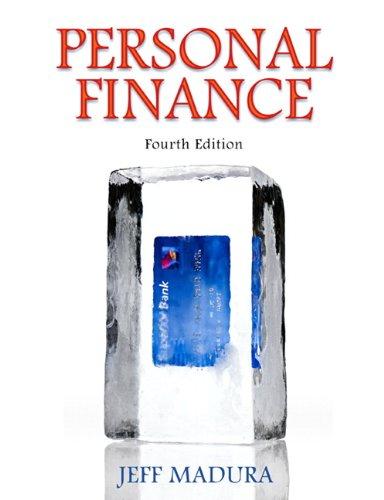Question
MULTIPLE CHOICE QUESTIONS: (CHOOSE 1 ANSWER PER QUESTION) If a leased asset were scrapped from a continuing CCA pool after four years, and its UCC
MULTIPLE CHOICE QUESTIONS: (CHOOSE 1 ANSWER PER QUESTION)
If a leased asset were scrapped from a continuing CCA pool after four years, and its UCC were $10,000 and its salvage is zero, what would the present value of this asset's tax shelter be if the appropriate after-tax borrowing rate is 9%, the CCA rate is 20%, and the tax rate is 40%?
Multiple Choice
-
-$2,759
-
-$1,955
-
+$10,000
-
+$2,759
If a financial analysis of a lease shows a negative result of $500, a manufacturer could alter the lease terms to make leasing profitable by:
Multiple Choice
-
cutting his price to the lessor by more than $500.
-
raising the CCA rate for the lessor.
-
raising salvage value by lowering the discount rate.
-
raising the lease terms
Canada Customs and Revenue Agency is suspicious of financial leases that exhibit the following non-lease characteristic:
Multiple Choice
-
the term is very long.
-
there is a down payment.
-
lease payments change in size over the lease term.
-
the lease allows the asset's title to pass to the lessee without significant cost at the lease's end
Which one of the following is not a cash flow item in financial lease analysis?
Multiple Choice
-
the lessor's repayment schedule for financing the asset.
-
the value of the salvage to the lessor.
-
the CCA tax shelters of the lessor.
-
the lease payment's tax shelter impacts for the lessee
Lease capitalization's value determination requires one of the following methods.
Multiple Choice
-
finding the net present value of future lease payments.
-
recording the asset's purchase price as the lessee's asset.
-
the lessor shows the asset's effect on his leverage.
-
altering the lessee's restrictive covenants by the amount of the asset's value
All of the following must be included on a company's balance sheet except:
Multiple Choice
-
capital leases.
-
sale and leaseback agreements.
-
operating leases.
-
leveraged leases.
Which of the following is not a normally attractive feature of an operating lease?
Multiple Choice
-
the lessee has the option to cancel.
-
the lessee only needs the equipment for a short time.
-
the lessee can't afford to buy the asset.
-
the lessor offers superior and cheaper maintenance than the lessee can perform.
As a practical matter, the lessee uses a single discount rate for lease analysis, but a more refined approach would do which of the following?
Multiple Choice
-
use a different discount rate for every line on the lease analysis' cash flows, and so reflect differing risk for each cash item.
-
use a zero discount rate for the lease payment, a high rate only for the CCA tax benefits, and a middle rate for the other cash flows.
-
use one discount rate for the lease tax shelter, and another for the other cash flows.
-
use a low, middle, and high discount rate and pick the average result
If the asset described in above Question had a CCA rate of 30%, with the usual half-year rule, and were leased for 5 years, how would the lessee treat the five years of CCA? The lessee tax rate is 40%. The asset class uses declining balance.
Multiple Choice
-
lessee would calculate the CCA amounts for each of the five years, apply the tax rate against these amounts, and show these amounts as cash outflows.
-
lessee would calculate the CCA amounts for the entire life of the asset, and show those amounts as cash flows.
-
lessee would ignore the CCA, since it is the lessor's financial province.
-
lessee would treat the CCA calculations for each of the five years of the lease as cash inflows for the lessor.
If an asset has a positive salvage of $1,000, exactly equal to UCC, then the lease analysis for an asset alone in its pool will show the following cash flows for that phenomenon.
Multiple Choice
-
the salvage is a cost to leasing; there is no terminal loss or gain.
-
the salvage is a cost of owning, the terminal loss is $1,000.
-
salvage has no effect on leasing, since it belongs to the owner.
-
the tax shelter for the terminal gain will be $1,000.
Step by Step Solution
There are 3 Steps involved in it
Step: 1

Get Instant Access to Expert-Tailored Solutions
See step-by-step solutions with expert insights and AI powered tools for academic success
Step: 2

Step: 3

Ace Your Homework with AI
Get the answers you need in no time with our AI-driven, step-by-step assistance
Get Started


